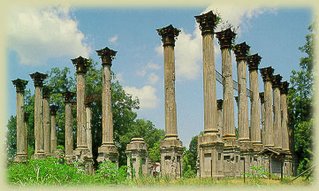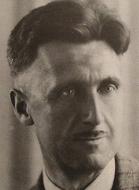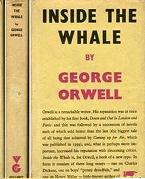A Visit To Eudora Welty
 It's a story told mostly in Eudora Welty biographies: Henry Miller comes to visit her in Jackson, Mississippi in 1941, during his cross-America Air-Conditioned Nightmare tour, and he comes off as boring and rudely disinterested. However, I think some biographical context will help explain his mood at that time and offer some balance to the negativity of this anecdote.
It's a story told mostly in Eudora Welty biographies: Henry Miller comes to visit her in Jackson, Mississippi in 1941, during his cross-America Air-Conditioned Nightmare tour, and he comes off as boring and rudely disinterested. However, I think some biographical context will help explain his mood at that time and offer some balance to the negativity of this anecdote. Eudora Welty (1909-2001) was a photographer and writer, primarly on the subject of her home state, Mississippi. In 1941, she was 32 and had been publishing short fiction for five years. A collection of her work called A Curtain Of Green was released in 1941 by Doubleday Doran & Co. Doubleday also happened to be the publisher that was putting up the money for Henry Miller's Nightmare tour (and, of course, the book that would result). John Woodburn, a Doubleday editor, is said to have been the one to suggest that Miller stop in on Welty in Jackson during his travels. Miller wrote to Welty before arriving in March.
Eudora Welty (1909-2001) was a photographer and writer, primarly on the subject of her home state, Mississippi. In 1941, she was 32 and had been publishing short fiction for five years. A collection of her work called A Curtain Of Green was released in 1941 by Doubleday Doran & Co. Doubleday also happened to be the publisher that was putting up the money for Henry Miller's Nightmare tour (and, of course, the book that would result). John Woodburn, a Doubleday editor, is said to have been the one to suggest that Miller stop in on Welty in Jackson during his travels. Miller wrote to Welty before arriving in March.The Visit Itinerary
(Approximately) the first week of March, 1941. Miller arrived without a car (it wasn't far away, in Natchez). Welty and her Southern literary friends Nash Burger and Hubert Creekmore drove Miller to the following local sights:
* Nanchez (city) [same as Natchez ??]
* the Ruins Of Windsor [image below] (a picnic here?)
* Civil War battlefield at Vicksburg
* Dinner at The Rotisserie (Jackson's first Greek restaurant) on all three nights.
 Criticisms From The Welty Camp
Criticisms From The Welty Camp* Miller was not interested in discussing his works with Creekmore [2];
* Welty: Miller did not remove his hat the entire time [2];
* While being given his personal driving tour, Miller would not even look out the winodw and seemed "infinitely bored" (Welty) [2];
* At picnics, he would say nothing [2];
* Miller was taken to the same restaurant three times, through three vastly different entrances; the third time he commented that he was surprised that a small town like Jackson would have three good restaurants (implying that he hadn't been paying enough attention to realize he'd already been there twice before) [1] [2] (drawn from [3]; on this on-line telling of the story, from an unknown and questionable source, Miller is said to have called Jackson a "hole").
Putting Miller's Mood In Context
Perhaps people had high expectations of Henry Miller's personality, based on the passionate and ribald biographical character he portrayed in his works. So why was he glum on this visit to Jackson? Here are a few possibilities:
1. His father had just died.
In February, his father Henry (Heinrich) Miller died suddenly at the age of 75. Miller had left his car in Natchez because he had to fly off to New York when he got word that his father was ill. He missed having a final goodbye with his father by two hours.
2. He had been traveling across America since October 1940.
Miller had been on the road for close to half a year at the time of his visit. It's entirely possible that he was feeling a bit of information overload by this point.
3. He may have just been rejected from Guggenheim funding.
Miller and his travel partner Abe Rattner had applied for grant money from the Guggenheim Foundation around September 1940. The winners were announced on March 23, 1941. Possibly, he had received a rejection notice before the annoucement (he felt angry enough about it that he included a list of the winners at the end of Air-Conditioned Nightmare).
4. He may have felt embarrassed around Welty.
When Miller wrote to Welty in 1940, he thought he was doing her a favour by offering to hook her up to the "unfailing pornographic market," in which he was dabbling at the time. To offer this to a female writer would not have seemed unusual to him, because he had been writing it with a group of others, half of whom were women (like Anais Nin). Between the time of the letter and the visit, however, Miller had developed a distaste for being involved with that kind of writing ("I don't want to do that work any more for anything": letter to Nin, Jan. 1941 - A Literate Passion). Eudora had shown the letter to her offended mother, who then made sure that Miller never set foot in the Welty home during his visit [1] [2].
In the published material that I've seen, Miller has never referenced Eudora Welty. Of this visit, only a couple of sentences about the Ruins Of Windsor made it into Air-Conditioned Nightmare (p.286). After his three-day visit, Miller picked up his car in Natchez and continued his American roadtrip. My guess is that he and Welty were never in touch again.
Welty biography sources: [1] Eudora Welty: A Biography (Suzanne Marrs), [2] Eudora: A Writer's Life (Ann Waldron). Much of this anecdote appears to come from a Welty interview in Conversations With Eudora Welty (Peggy Whitman Prenshaw) [3].














